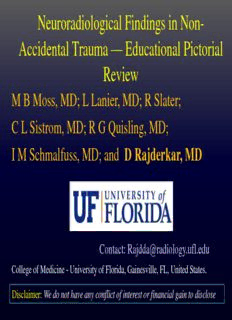
Neuroradiological Findings in Non- Accidental Trauma PDF
Preview Neuroradiological Findings in Non- Accidental Trauma
Neuroradiological Findings in Non- Accidental Trauma — Educational Pictorial Review M B Moss, MD; L Lanier, MD; R Slater; C L Sistrom, MD; R G Quisling, MD; I M Schmalfuss, MD; and D Rajderkar, MD Contact: [email protected] College of Medicine - University of Florida, Gainesville, FL, United States. Disclaimer: We do not have any conflict of interest or financial gain to disclose Outline 1. Simulation-SIM as assessment tool 2. Clinical and Neuroradiolgical findings of Non- Accidental Trauma (NAT) 3. Pitfalls Congenital infections Birth related injuries e.g. subdural tentorial hematomas 4. Search pattern to prevent observational errors 5. Assertive guidelines to call NAT to avoid cognitive errors 6. Recommended imaging plan for a follow up Background ➢Computer aided simulation (SIM) was developed and designed to test residents for readiness for call ➢8 hour simulation of 65 emergent & critical care cases of varying degrees of difficulty, including normal studies using full DICOM image sets ➢SIM was taken by 127 first (R1) & second (R2) year residents from 16 USA radiology training programs Results ➢75% of the residents either called the study normal (observational error) or gave an incorrect diagnosis (cognitive error) ➢No significant difference between R1 and R2 residents with an average scores of 17 versus 25% respectively Conclusion: Significant observational and cognitive gap exists in detecting and differentiating NAT from other disease entities Neuro NAT Manifestations Brain: Axial loading injury - Skull fracture High impact trauma - Skull base fracture & brain injury Penetrating trauma Shaking Injury - Diffuse axonal injury & SDH Shearing injury Venous tethering Asphyxiation/Hypoxic brain injury Long term sequelae - Global atrophy Spine Axial loading injury - Vertebral compression fracture Spinal cord injury SIM Case 1 2 75% of the residents failed to make the diagnosis indicating the need to revisit 4 3 the radiology of NAT Fig 1 - Extensive scalp hematoma (white arrows) with associated skull fracture (red arrows) Fig 2 - Right sided posterior rib fractures (yellow arrows), better identified on zooming (Fig 3) and changing windows (Fig 4) Traditional Radiology Teaching of Neuro NAT Prominent extra-axial spaces (between Larger subdural hemorrhage (SDH) (white purple arrows) predispose for extra-axial arrows) is an uncommon spontaneous event bleeding after getting shaken. Repetitive in infants. Other types of blood collections shaking leads to mixed age of extra-axial include: subpial (yellow arrow) & intradural blood products (white arrows). (pink arrow) hemorrhage and subdural hygromas (purple arrows) Traditional Radiology Teaching of Neuro NAT Fig 1 & 2 - Axial loaded skull fracture (red arrows) Typical transverse fracture of the temporal bone (red arrows) 1 2 3 4 Axial CT (Fig 3) shows transverse oriented fracture (pink arrow) with its complete extent better demonstrated with on the 3D reformation (Fig 4) A complete review of the additional findings in NAT Cervical Spine/Cord Injury Most commonly from a shaking/”whiplash” type mechanism May damage the lower brainstem and upper cervical cord • Could present as apnea and hypoxia. Subdural and epidural cord hematomas, cord contusion and ligamentous rupture Cervical spine MRI must be performed if there is any clinical suspicion of shaking-type injury Spinal Trauma Axial loaded associated Long segment spinal cord spinal column injury edema 1 2 Sagittal (Fig 1) & axial (Fig 2) T2 images reveal spinal cord edema extending from Lateral lumbar spine X-ray shows the foramen magnum to C7 typical compression deformity of level (red arrows) a vertebral body (white arrow) Teaching point: Cervical spine CT without bony injury is clearly underestimates the extent of cord injury
Description: